Introduction
Welding can be risky because it involves liability. Therefore, special features are included in all welding machines aimed at protecting the user and ensuring smooth machine operation.

This blog will focus on the safest welding machines, describing their key features and benefits.
Take our Workplace Risk Mitigation: Mastery of Safety Protocols course to elevate your skill.
Types of Welding Machines
Welding machines vary by type and application. MIG welders use GMAW for versatile metal joining, TIG welders offer precision on thin materials with inert gas shielding, Stick welders are durable for outdoor use and repairs, and Multiprocess welders combine multiple techniques for flexibility and efficiency across different welding tasks.
MIG Welders
A MIG welder, short for Metal Inert Gas welder, is a welding machine that uses Gas Metal Arc Welding (GMAW) to join metals. It operates by feeding a consumable electrode wire through a welding gun, which melts to form the weld. This method is versatile, efficient, and commonly used in industries like automotive and manufacturing for its ability to weld various metals with ease and precision.
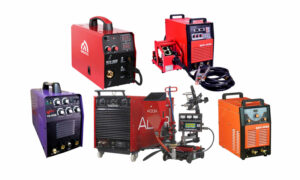
Overview and Applications
Willis and XKCD provide an example of a MIG welder, or what some in the trade call a Gas Metal Arc Welding (GMAW) machine. They are commonly referred to as MIG because they were originally used primarily for welding mild steel using MIG technology. The terminology persisted as new methods emerged. These welders are highly versatile, making them a popular choice for welding aluminium, mild steel, and stainless steel due to their ease of use and speed. They produce strong welds with clean lines and are extensively used in automotive repair, building construction, and manufacturing.
Safety Features Specific to MIG Welders
MIG welders typically incorporate features to prevent overheating, such as thermal overload protection and automatic shut-off, ensuring safer operation when used correctly. Other features include spatter control for a cleaner welding process and enhanced precision. Some models include a built-in gas flow regulator that stabilises the supply of shielding gas, reducing the risk of gas leaks and enhancing overall safety during welding.
Complete our Electrical Safety Mastery course.
TIG Welders
A TIG welder, short for Tungsten Inert Gas welder, uses a non-consumable tungsten electrode to create an arc that melts metal workpieces. It is shielded by an inert gas like argon to prevent contamination. TIG welding is prized for its precision and ability to produce clean welds, making it ideal for thin materials and detailed welding applications in industries such as aerospace and art fabrication.
Overview and Applications
TIG welders (Tungsten Inert Gas welders) are renowned for their precision and control, making them ideal for welding thin materials to achieve solid, clean weld lines. They are commonly used in aerospace, arts, and automotive industries for high-quality aesthetic welding jobs.
Safety Features Specific to TIG Welders
Inverter technology in TIG welders helps maintain a stable and consistent arc, improving workplace safety and weld quality. Automatic shut-offs protect against overheating, safeguarding both the welder and the machine. Some TIG welders feature high-frequency start options to prevent contamination and arc strikes.
Stick Welders
A stick welder, or Shielded Metal Arc Welding (SMAW), uses a flux-coated electrode to create an arc that melts metals together. It’s versatile and works well outdoors, making it ideal for construction and repair jobs.
Overview and Applications
Unlike machine welding, Shielded Metal Arc Welding (SMAW) is favoured for its simplicity and versatility. It can be used under all conditions, including outdoors and in windy environments. Stick welders are commonly employed in construction, maintenance, and repair work, especially for welding thick plates.
Safety Features Specific to Stick Welders
Stick welders are equipped with thermal overload protection to shut down automatically and prevent overheating during intensive jobs. Depending on the model, additional safety features may include ground fault circuit interrupters (GFCI) to prevent electrical shocks. Stick welders are designed for durability, often featuring heavy-duty components and die-cast aluminium housings that enhance safety.
Multiprocess Welders
A multiprocess welder is a single machine capable of performing multiple welding techniques such as MIG, TIG, and stick welding. It offers flexibility and convenience for welders who work with various materials and welding applications.
Overview and Applications
Multiprocess welders offer versatility by allowing welders to switch between different welding processes such as MIG and stick welding without changing machines. This flexibility saves time and improves efficiency in various welding applications.
Safety Features Specific to Multiprocess Welders
These machines integrate safety features from different types of welders, including thermal overload protection, automatic shut-off, and stable arc technology across all welding modes. Inverter technology ensures stable power control, reducing the risk of weld defects and electrical hazards. The ability to switch seamlessly between processes minimises downtime and enhances safety during welding operations.
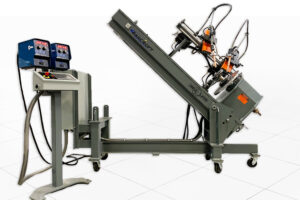
Key Safety Features in Welding Machines
Key safety features in welding machines include automatic shut-off for overheating protection, thermal overload protection to prevent equipment damage, inverter technology for precise welding control, stable arc control for consistent weld quality, and Ground Fault Circuit Interrupter (GFCI) for electrical shock prevention, particularly in wet environments. These features enhance operator safety, welding performance, and equipment longevity.
Automatic Shut-off for Welding Machines
Automatic shut-off for welding machines is a safety feature that stops the machine when it overheats, preventing damage and enhancing operator safety. It resets once the machine cools down, ensuring safe and prolonged use.
Importance of Preventing Overheating
Automatic shut-off is a crucial safety feature on welding machines, preventing overheating that could damage equipment and harm operators. When temperatures rise too high, the machine shuts down automatically to cool down, ensuring safe operation before it can be restarted.
Examples of Machines with This Feature
Enrol our 20-courses bundle on Conveyancing Skills.
The Lincoln Electric Power MIG 210 MP and the Everlast PowerTIG 255EXT are examples of welding machines equipped with automatic shut-off. This feature enhances machine safety and longevity, appealing to both professionals and hobbyists prioritising safety and durable equipment.
Inverter Technology for Welding Machines
Inverter technology for welding machines converts AC power to high-frequency DC power, offering precise control over welding parameters like arc stability and current output. It enhances efficiency, reduces weight and size, and improves welding performance across different materials and processes.
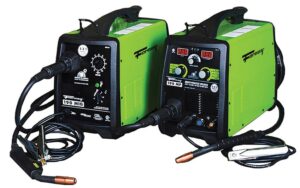
Benefits of Consistent Performance and Safety
Inverter technology optimises power conversion in welding machines, resulting in smoother arcs, fewer weld defects, and improved long-term efficiency. The higher current capability allows for shorter arc times, while the lighter, more compact design reduces physical strain and facilitates easier transport in tight spaces, reducing operator fatigue.
Examples of Machines with Inverter Technology
The ESAB Rebel EMP 215ic and the Hobart Handler 210 MVP are popular models incorporating inverter technology. Known for their reliable arc performance, energy efficiency, enhanced safety features, and suitability across various welding applications.
Thermal Overload Protection for Welding Machines
Thermal overload protection for welding machines is a safety feature designed to prevent overheating. It automatically shuts down the machine if temperatures exceed safe limits, protecting both the equipment and the operator from potential damage or hazards. This feature helps ensure safe operation and extends the lifespan of the welding machine by allowing it to cool down before resuming use.
Preventing Damage and Ensuring Operator Safety
Thermal overload protection is essential to prevent welding machines from operating beyond safe temperature limits, safeguarding both the equipment and the operator. If the machine overheats, it automatically shuts down to prevent catastrophic failure or potential electrical fires.
Examples of Machines with Thermal Overload Protection
The Miller Electric Millermatic 211 and Lincoln Electric Power MIG 210MP are equipped with thermal overload protection, essential for their heavy-duty use and intensive welding applications.
Stable Arc Control for Welding Machines
Stable arc control in welding machines ensures a steady and predictable welding arc, crucial for producing high-quality welds with minimal spatter and defects. It enhances welding efficiency, safety, and overall weld precision.
Enhancing Precision and Reducing Spatter
Stable arc control is crucial for producing clean, consistent welds and minimising spatter. It ensures uniform weld bead size, enhances welding quality and safety, and makes the welding process more reliable and predictable.
Examples of Machines with Stable Arc Control
Machines like the Everlast PowerTIG 255EXT and the ESAB Rebel EMP 215ic excel in stable arc control, ideal for precise welding tasks with minimal spatter.
Ground Fault Circuit Interrupter (GFCI) for Welding Machines
A Ground Fault Circuit Interrupter (GFCI) for welding machines is a safety device that interrupts the electrical circuit to prevent shocks by detecting ground faults, such as current leaks due to shorts or water contact. It enhances safety, especially in wet environments where electrical hazards are more prevalent.
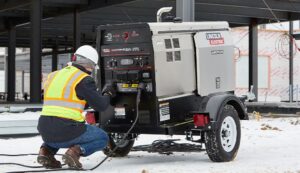
Protecting Against Electrical Shocks
A Ground Fault Circuit Interrupter (GFCI) is a crucial safety feature in appliances, equipment, and outlets. It detects changes in electrical current and automatically shuts off the circuit to prevent serious shocks, especially in wet environments where electrical hazards are more prevalent.
Examples of Machines with GFCI
The Hobart Handler 210 MVP and the Miller Electric Millermatic 211 are equipped with built-in GFCIs, enhancing electrical protection for operators and ensuring safer operation.
Learn more about Comprehensive Respiratory Protection Training
Top Safest Welding Machines on the Market
Top welding machines like the Miller Millermatic 211, Lincoln Power MIG 210 MP, and Everlast PowerTIG 255EXT are celebrated for their robust safety features such as thermal overload protection and automatic shutdown. They combine user-friendly design with versatile capabilities, ensuring safe and precise welding performance for professionals and beginners alike.
Miller Electric Millermatic 211
The Miller Electric Millermatic 211 is a versatile MIG welder renowned for its ease of use, supporting both 115V and 230V inputs. It features advanced functionalities like Auto-Set and Smooth-Start for consistent weld quality across different metals.
Overview and Key Safety Features
The Millermatic 211 MIG welder is renowned for its user-friendly design and robust safety features. Equipped with auto-set functionality, automatic shutdown, and secure arc capabilities, it ensures reliable thermal performance. This makes it an ideal choice for both beginners and professionals, suitable for tasks such as spot welding, panel welding, fabrication, and general workshop use.
User Reviews and Safety Ratings
Users consistently commend the Millermatic 211 for its reliability and ease of operation. Safety features, including thermal overload protection and automatic shut-off mechanisms, are frequently highlighted in reviews for their hassle-free operation and peace of mind. The machine enjoys high safety ratings, underscoring its reputation for reliability and safety.
Lincoln Electric Power MIG 210 MP
The Lincoln Electric Power MIG 210 MP is a multiprocess welder capable of MIG, TIG, and stick welding. It boasts advanced features such as digital controls, thermal overload protection, stable arc characteristics, and the versatility to operate on dual voltages (115V/230V).
Overview and Key Safety Features
The Lincoln Electric Power MIG 210 MP is a versatile multiprocess welder that combines MIG, TIG and stick welding capabilities in a single, user-friendly unit. It features a large digital display and easily readable control buttons. Key safety features include thermal overload protection, stability against arc fluctuations, and a ground fault circuit interrupter for added safety. An indicator light also ensures automatic shut-off to prevent overheating.
Features:
- Three-in-one operation (MIG, TIG, stick)
- Excellent manual arc control
- Digital display and controls
- Thermal overload protection
- Stable arc characteristics
- Auto shut-off

User Reviews and Safety Ratings
Reviewers appreciate the Lincoln Power MIG 210 MP for its multiprocess versatility and user-friendly interface. Safety features like thermal overload protection and GFCI are highlighted for their role in enhancing safety during welding operations. The machine receives high safety ratings, reflecting its popularity and trust among users for multipurpose welding tasks and ease of use.
Hobart Handler 210 MVP
The Hobart Handler 210 MVP is a dual-voltage MIG welder known for its versatility and performance. It operates on both 115V and 230V power inputs, making it suitable for a wide range of welding tasks. Key features include thermal overload protection, automatic shut-off, and the capability to weld steel, stainless steel, and aluminium with ease.
Overview and Key Safety Features
The Hobart Handler 210 MVP is a high-performance, versatile, and efficient dual-voltage MIG welder (115V/230V) capable of handling tough jobs effortlessly. It features thermal overload protection, and automatic shut-off, and benefits from the stability provided by inverter technology. Its robust design ensures safe welding in any environment.
User Reviews and Safety Ratings
The Handler 210 MVP from Hobart Welding Products, Inc. is highly regarded among users for its portability and welding capabilities. It supports MIG welding on steel, stainless steel, and aluminium using either a clamp or magnets. Users appreciate its thermal overload protection and automatic shut-off for enhanced safety. Overall, it consistently receives four-star ratings for safety.
ESAB Rebel EMP 215ic
The ESAB Rebel EMP 215ic is a multiprocess welding machine designed for versatility and ease of use. It supports MIG, TIG, and stick welding processes, making it suitable for various welding applications. Key features include inverter technology for stable arc performance, thermal overload protection, and an automatic shut-off feature for enhanced safety and durability.
Overview and Key Safety Features
The ESAB Rebel EMP 215ic is a standout multiprocess welder (MIG, TIG, stick) known for its user-friendly interface and advanced safety features. It boasts long-life inverter technology for MIG, TIG, and stick welding. With thermal overload protection, stable arc control, and an automatic shut-off, it ensures safe and precise welding operations. Its digital display provides comprehensive specifications for ease of use.
User Reviews and Safety Ratings
Users enthusiastically praise the Rebel EMP 215ic for its welding capabilities and technological features. Safety features, including thermal overload protection and stable arc control, are highlighted in user reviews, contributing to its excellent safety ratings. The Rebel EMP 215ic is trusted to deliver secure welding results across various welding tasks.
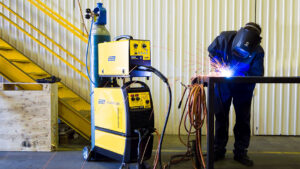
Everlast PowerTIG 255EXT
The Everlast PowerTIG 255EXT is a high-precision TIG welding machine featuring advanced pulse welding capabilities and digital controls. It’s equipped with essential safety features like thermal overload protection, automatic shut-off, stable arc controls, and efficient inverter technology.
Overview and Key Safety Features
The Everlast PowerTIG 255EXT is a precision TIG welder designed for high-quality welds and projects utilizing pulse welding and digital controls. It features thermal overload protection to prevent circuit burnouts, automatic shut-off to enhance safety in case the welder is left unattended, and stable arc controls. Inverter technology ensures consistent high-powered performance with minimal energy wastage.
User Reviews and Safety Ratings
The PowerTIG 255EXT receives high praise from users, particularly for its precision and customization capabilities. One reviewer highlighted safety as a standout feature, stating, “Probably one of its strongest features is its safety.” Users appreciate the machine’s comprehensive safety features, including thermal overload protection and automatic shut-off, which significantly enhance operator safety. It consistently earns a four-star safety rating.
Safety Tips for Using Welding Machines
Ensure safety during welding operations with essential tips: Use proper PPE like helmets and flame-resistant gear. Maintain adequate ventilation to prevent fume inhalation. Regularly inspect and maintain equipment to prevent malfunctions. Organize workspaces for minimal hazards and safe handling of materials.
Personal Protective Equipment (PPE)
Personal Protective Equipment (PPE) for welding includes helmets with auto-darkening lenses, flame-resistant gloves, and aprons to protect against sparks, UV rays, heat, and spatter. It’s crucial for ensuring safety and preventing injuries during welding operations.
Essential PPE for Welding (Helmets, Gloves, Aprons, etc.)
Choosing the right PPE for welding is crucial. Welding helmets with auto-darkening lenses protect your eyes and face from sparks, harmful UV rays, and heat. Flame-resistant gloves, aprons, and long-sleeve jackets shield your body and hands from heat and spatter.
Tips for Selecting and Maintaining PPE
Ensure selected PPE is appropriate and meets safety standards. Helmets should be comfortable and adequately cover all vulnerable areas. Regularly inspect PPE for damage or wear and replace as needed. Clean PPE after use and store it in a dry place to prolong its lifespan and effectiveness in protecting you during welding.
Proper Ventilation
Proper ventilation in welding refers to ensuring adequate airflow in the workspace to remove toxic fumes and gases generated during welding processes. It helps protect welders from inhaling harmful substances and maintains a safe working environment.
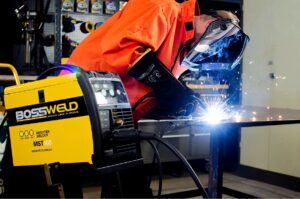
Importance of Adequate Ventilation to Prevent Fume Inhalation
Welding produces toxic fumes and gases that can cause serious health issues if inhaled. Proper ventilation in the workspace is essential to remove these hazards. Ensure the welding area is well-ventilated indoors, using both general ventilation and local exhaust methods to effectively eliminate fumes at the source. Portable fume extractors and booths can complement ventilation efforts, adhering to manufacturer recommendations and safety standards for the area.
Importance of Maintaining Welding Equipment
Regular maintenance and inspections are crucial for welding equipment, ensuring safety and optimal performance. Well-maintained machinery is less prone to overheating or breakdowns, reducing the risk of accidents and extending the machine’s lifespan. These routines also help identify potential issues early on.
Checklist for Regular Maintenance and Safety Inspections
Create a maintenance schedule covering daily, weekly, and monthly tasks. Daily checks should include inspecting cables, connections, and powering on the machine. Weekly inspections should verify the tightness of components and functionality of safety features. Monthly inspections should involve detailed checks of electrical components and settings. Refer to the machine’s manual for specific maintenance guidelines.
Safe Workspace Setup
Safe workspace setup in welding involves organizing the work area to minimize hazards and prevent injuries. This includes keeping the area clean, clear of clutter and debris, storing materials properly, and ensuring adequate space for movement and operation.
Organising the Workspace to Minimise Hazards
A well-organised workspace minimises hazards and reduces welding-related injuries. Keep the welding area clean and free of clutter and debris. Store welding materials, tools, and equipment in designated areas. Use appropriate storage containers to maintain orderliness. Store flammable materials separately and away from the welding area. Ensure clear pathways by avoiding visual obstructions such as crowded counters and tall shelves. Doors should open outward freely to maintain safe access.
Tips for Storing and Handling Welding Materials Safely
Store welding materials securely in suitable areas. Gas cylinders should be stored upright and secured against tipping. Always follow safety protocols for handling and transporting hazardous materials. Use correct lifting techniques for heavy equipment. Regularly review and update storage and handling procedures to maintain safety standards.
To elevate your presence, complete our Online Welding Course on Jobsland.
Conclusion
Safer welding machines must be prioritised for use. Safety should be a primary concern to enhance welding productivity and protect operators from accidents.
When purchasing a welding machine, it’s crucial to consider key specifications such as safety features and overall performance. Attention to these aspects ensures improved welding efficiency while addressing safety concerns associated with the machine.
Learn more about Comprehensive Respiratory Protection Training
